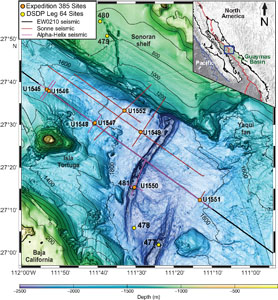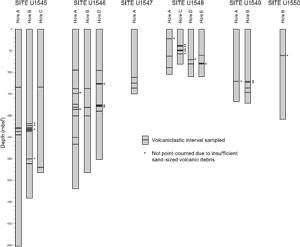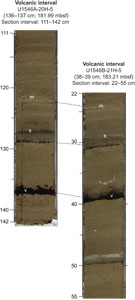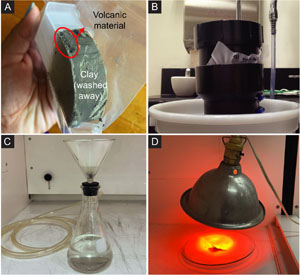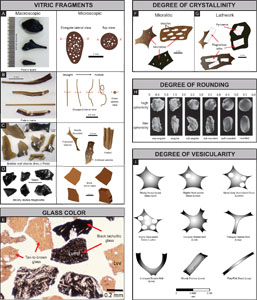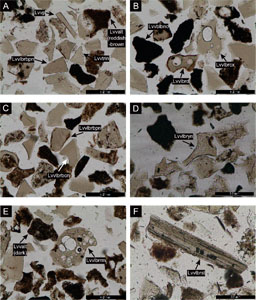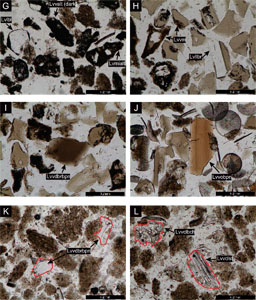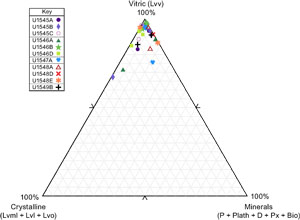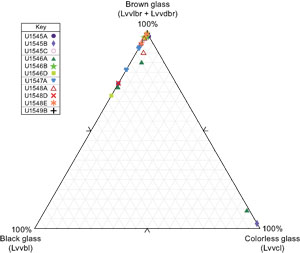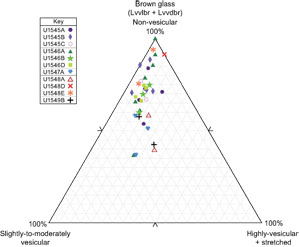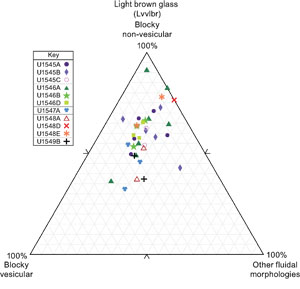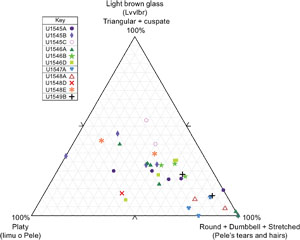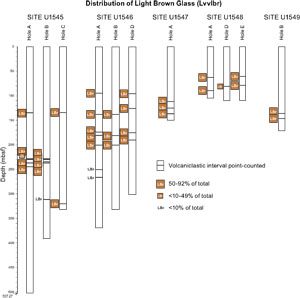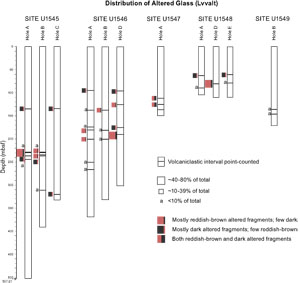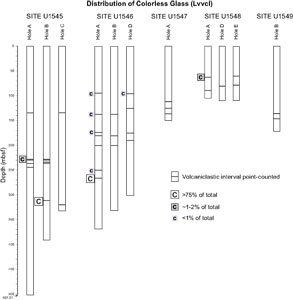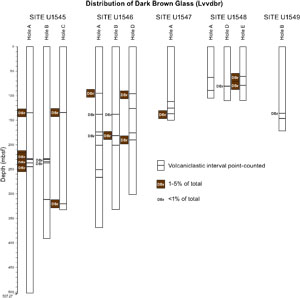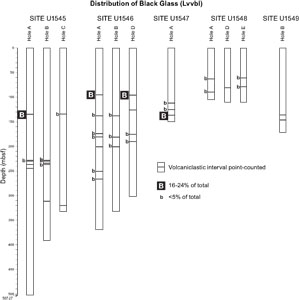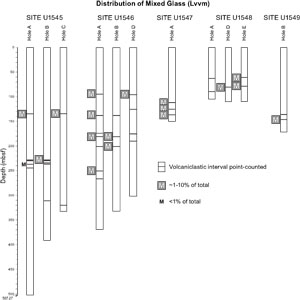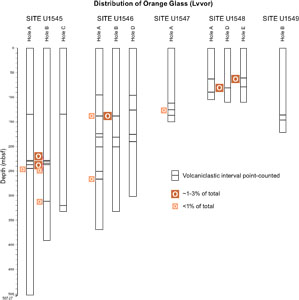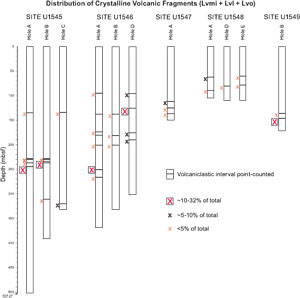Teske, A., Lizarralde, D., Höfig, T.W., and the Expedition 385 Scientists
Proceedings of the International Ocean Discovery Program Volume 385
publications.iodp.org
https://doi.org/10.14379/iodp.proc.385.206.2025
Data report: petrography of volcaniclastic intervals in IODP Expedition 385 cores from Guaymas Basin, Gulf of California1
Priscilla R. Martinez,2, 3 Kathleen M. Marsaglia,2 and Joann M. Stock4
1 Martinez, P.R., Marsaglia, K.M., and Stock, J.M., 2025. Data report: petrography of volcaniclastic intervals in IODP Expedition 385 cores from Guaymas Basin, Gulf of California. In Teske, A., Lizarralde, D., Höfig, T.W., and the Expedition 385 Scientists, Guaymas Basin Tectonics and Biosphere. Proceedings of the International Ocean Discovery Program, 385: College Station, TX (International Ocean Discovery Program). https://doi.org/10.14379/iodp.proc.385.206.2025
2 Department of Geological Sciences, California State University Northridge USA. Correspondence author: priscmartinez@arizona.edu
3 Present affiliation: Department of Geosciences, University of Arizona, USA.
4 Seismological Laboratory, California Institute of Technology, USA.
Abstract
The Guaymas Basin is a 6 Ma transtensional ocean basin located in the central Gulf of California characterized by active seafloor spreading, off-axis magmatism, and high biogenic and terrigenous sedimentation rates. Sparse volcaniclastic intervals were identified by shipboard scientists in Quaternary sedimentary cores recovered during International Ocean Discovery Program (IODP) Expedition 385. Shipboard visual core descriptions and smear slide analyses were used to identify 57 volcaniclastic intervals, which were then sampled and analyzed macroscopically and microscopically. Petrographic modal analyses were conducted on a subset of 36 thin sections with a total of 300 points counted per thin section. A grain classification scheme was developed from published literature to characterize the compositional and textural variability of volcanic grains in cores from across the basin. Point count percentages reveal that vitric volcanic lithic fragments, particularly brown glass shards, are the dominant clast type observed at all drill sites, whereas crystal-bearing volcanic lithic fragments and mineral grains comprise a minor percentage of the total points counted. The vitric fragments also exhibit a wide range of shard vesicularity and morphologies. This data report presents a petrographic analysis of volcaniclastic deposits recovered during Expedition 385 to elucidate on the modal and spatial distribution of volcanic material in the Guaymas Basin.
1. Introduction
Deep Sea Drilling Project (DSDP) Leg 64, conducted in 1978–1979, was the first major deep-sea drilling effort to target the Guaymas Basin with the objective of investigating the interaction of igneous intrusions and sediments in this rapidly rifting, nascent ocean basin located in the central Gulf of California (Curray, Moore, et al., 1982). The published Leg 64 Proceedings volume (Curray, Moore, et al., 1982) contains more than 60 postcruise studies by the Shipboard Scientific Party, including a sedimentologic study by Einsele and Kelts (1982) that better constrained the distribution of turbidites and gravity-flow deposits in the basin. Einsele and Kelts (1982) also proposed that volcanic sand intervals recovered at DSDP Sites 477, 478, and 481 were likely produced by local submarine volcanoes. Petrographic analysis of Leg 64 sand and sandstone samples by Marsaglia (1991) suggests that the basin receives sediment from various sources, including drainage runoff from the Miocene–Pleistocene volcanic terranes on Baja California Sur, Sonora, and Yaqui Rivers from eastern mainland Mexico, and potential volcanic sand and pyroclastic debris from intrabasinal volcanic centers, such as Isla Tortuga.
International Ocean Discovery Program (IODP) Expedition 385 revisited the Guaymas Basin in 2019, recovering 4.2 km of Quaternary sediment and igneous rocks from Sites U1545–U1552 (Teske et al., 2021a; Figure F1). Shipboard scientists identified and sampled sparse volcaniclastic intervals (n = 57) in cores from Sites U1545–U1550 (Figure F2). A composite summary of macroscopic and microscopic analyses for all 57 intervals are detailed in Martinez (2022). A subset of 36 of the 57 samples collected was selected for petrographic analysis in this study based on the abundance and quality of the volcanic material in each sample. The first goal of this project was to create a classification scheme for volcanic particles that depicts 2-D slices of 3-D mafic pyroclasts, hydroclasts, and epiclasts described in published literature. Petrographic analyses revealed that various glass colors, which function as proxies for composition (see discussions in Marsaglia, 1991, 1992, 1993), are found in the basin, including light and dark brown (intermediate to mafic sideromelane), black (mafic tachylite), colorless (silicic pyroclasts), altered, mixed, and orange (palagonite) glass, along with crystal-bearing vitric fragments and trace mineral grains. The vitric particles also exhibit a wide range of glass shard vesicularity and morphologies, including blocky, platy, cuspate, and other distinct fluidal textures. The second goal was to apply the scheme to volcaniclastic intervals recovered during Expedition 385 by conducting point count analyses on a subset of thin sections to document modal percentages of those components. Here, we outline the compositional and textural attributes of volcaniclastic intervals from cores drilled at Expedition 385 sites to provide insights into the downhole variability and spatial distribution of volcanic material in the Guaymas Basin.
2. Methods
Unlithified, silt to sand volcaniclastic intervals were first identified by Teske et al. (2021a) in cores from Holes U1545A–U1545C, U1546A, U1546B, U1546D, U1547A, U1548A, U1548C, U1548D, U1548E, U1549A, U1549B, and U1550B (Figure F3). A total of 57 intervals were sampled by repository staff from cores stored at the IODP Gulf Coast Repository in College Station, Texas (USA) (Table T1). Preliminary smear slide and binocular stereomicroscope observations were made after air drying the samples to identify targets for petrographic analyses. Those targeted samples were then wet sieved to remove the <30 µm fraction and other biosiliceous debris to aid in the concentration of coarser volcanic material using the wet-sieving methods described in Sarna-Wojcicki et al. (2005; Figure F4). The wet-sieving procedure involved washing the disaggregated sample through successively finer sieves into plastic beakers, decanting water while retaining settled solids. Each sample was sieved and dried into three fractions: >150 µm for macroscopic analysis, 80–150 µm for petrographic analysis, and 80–30 µm for archival purposes. The <30 µm fraction was not retained, and the procedure did not include the use of any deflocculant or chemical treatment to disaggregate clays from vitric or other mineral particles. Standard thin sections were prepared from sand fractions, primarily the 80–150 µm fractions, and ground to a thickness of 30 µm.
To facilitate volcanic clast identification in thin section, a classification scheme for mafic volcanic particles was developed based on macroscopic (binocular microscope) and microscopic images (scanning electron microscope and photomicrograph) from published studies of mafic epiclastic, pyroclastic, and hydroclastic deposits by Heiken (1972), Fisher and Schmincke (1984), Marsaglia (1993), Clague et al. (2009), Gadley and Marsaglia (2005), and many others (Figure F5). The classification scheme was devised specifically to depict 2-D slices as observed in thin section of 3-D mafic particles and expands on the vitric textures outlined by Fisher and Schmincke (1984). Elements of the classification scheme are listed in Table T2. Additionally, previous workers (e.g., Marsaglia, 1992, 1993) have broadly linked glass color to composition, and these associations reasonably hold in this study: black (mafic tachylite), brown (mafic to intermediate sideromelane), and colorless (felsic glass or pumice). The classification scheme developed here straddles both epiclastic and pyroclastic realms but with 2-D petrographic description rather than 3-D shape as used in eruption-mode and fragmentation-focused volcanic glass studies (Portner et al., 2015; Dürig et al., 2020b, 2020a); notably, our scheme can be applied to lithified and even diagenetically modified units (e.g., units described by Marsaglia [1991] during Leg 64 within central graben sites). The volcanic lithic fragment (Lv) terminology is commonly used for beach and stream sand on volcanic islands and terrains (e.g., Marsaglia, 1993; Critelli and Ingersoll, 1995; Morrone et al., 2018, 2020) and with cases of lithified volcaniclastics associated with incipient arc magmatism and seamounts (Allen, 2021; Rains et al., 2012; Waldman et al., 2021; Critelli et al., 2002; Marsaglia et al., 1999). The latter are mainly petrologic rather than eruption mode oriented, with volcaniclastic particles of variable origin mixed during littoral to deep marine transport.
Of the 57 sampled intervals, 36 samples were selected for point count analyses based on the abundance and quality of the volcanic material in each sample. To determine compositional and textural modes, a Swift automated stage and point counting system affixed to a Nikon Optiphot petrographic microscope were used to count a total of 300 points on each thin section. Shipboard scientists noted that the mafic silt and sand intervals later sampled for this study included a mix of epiclastic and pyroclastic debris. This debris had been reworked and deposited in the basin (Teske et al., 2021a). We apply the Gazzi-Dickinson method for petrographic analyses (Dickinson, 1970; Ingersoll et al., 1984), which divides volcanic lithic fragments into various compositional and textural types and requires that all sand-sized mineral components in lithic fragments be counted as separate grains. We adopted and modified categories from previous studies of dominantly volcaniclastic intervals that also used this technique (e.g., Hawaii [Marsaglia 1991], Izu-Bonin magmatic arc [Marsaglia, 1992], Circum-Pacific magmatic arcs [Marsaglia and Ingersoll, 1992], and Aeolian magmatic arc [Morrone et al., 2017]). These studies examined epiclastic and pyroclastic debris likely modified by submarine and/or littoral transport and referred to as volcanic lithic debris. The term “lithic” is used in the sedimentologic not volcanological sense. The presence of siliceous and calcareous bioclasts in each sample was noted because they were locally significant, but they were not included in the 300 point total. Several schemes of recalculated parameters (Table T2) were then devised to illustrate the compositional and textural variability of the volcaniclastic intervals because of the wide range of grain assemblages observed within the samples. Parameter abbreviations are those of previous petrographic studies (e.g., Marsaglia, 1993; Critelli and Ingersoll, 1995; Morrone et al., 2017, 2018, 2020) that divide the Lv into various subcategories (Table T2).
3. Results
Preliminary core image, binocular stereomicroscope, thin section, and smear slide observations used to facilitate point count analyses are detailed in Martinez (2022). The point count categories identified in this study are expanded from those defined by Dickinson (1970) to include glass fragments and mineral grains divided by composition and morphology (i.e., degree of vesicularity), along with their associated definitions and recalculated parameters (Table T2). Figure F6 consists of photomicrographs of select common grain types observed in thin section and assigned as point count categories for petrographic analysis. The point count data for 36 thin sections produced from this analysis are found in Table T3. The proportions of vitric composition categories calculated from the bulk vitric point count population (lithic volcanic with vitric texture [Lvv]) for each sample are listed in Table T4. Compositional and textural variability at Sites U1545–U1549 are displayed in ternary plots in Figures F7, F8, F9, F10, and F11 that were constructed using recalculated parameters of raw point count data shown in Table T5. The raw point count data are expressed as bulk percentages in Table T6 to demonstrate distributions and trends for vitric fragment compositions within and among sites, as illustrated in Figures F12, F13, F14, F15, F16, F17, F18, and F19.
3.1. Compositional modes
The point count data for the 36 samples counted (10,800 total grains) indicate that vitric volcanic lithic fragments comprise an average of 91.2% of the total composition of these intervals, and crystal-bearing volcanic lithic fragments and mineral grains comprise an average of 5.02% and 3.76%, respectively (Table T5; Figure F7).
The volcanic lithic fragments (Lvv) mentioned above can be further divided as follows: light brown (70.2%), nontranslucent altered (17.2%), colorless (5.2%), black (3.7%), mixed brown/black (2.2%), dark brown (1.1%), and orange (0.4%) glass (Table T4). The prevalence of brown and black colors suggests a predominant intermediate to mafic composition signature within the vitric component point count population. Brown, colorless, and orange glass fragments appear mostly translucent in transmitted light, with dark brown glass having a slightly lower translucency than all other glass types (Figure F6). In transmitted light, black glass fragments are opaque and commonly contain plagioclase microlites and laths surrounded by fine opaque minerals, referred to as tachylite. In contrast, the colorless vitric fragments are translucent and lack crystals. Figure F8 illustrates the distribution of brown (light and dark), black, and colorless glass in the sample suite, highlighting the high abundance of brown glass across all sites, except for two samples from Holes U1545B and U1546A, which primarily consist of colorless glass. Altered glass colors vary from reddish brown to dark gray to black and are likely products of intermediate to mafic glass (Figure F6G). The vitric fragments referred to as “mixed” glass appear to be composed of a combination of light brown and black glass, but it is unknown if this component represents a distinct type of alteration or if it is an actual mix of two glass types that formed contemporaneously (Figure F6H). Orange glass shards are rarely observed throughout each site but are characteristically translucent in transmitted light and likely palagonitic in composition (Figure F6J).
Crystal-bearing volcanic fragments exhibit vitric groundmasses that span all color varieties and contain microlites (<63 µm; lithic volcanic fragment with microlitic texture [Lvml]) or laths (>63 µm; lithic volcanic fragment with lathwork texture [Lvl]) of plagioclase (Figure F6G, F6H). On average, lithic volcanic fragments with crystalline textures range from microlitic (2.1%) and lathwork (2.6%) fragments to polyminerallic (holocrystalline) grains (0.35%). The monomineralic grains identified in the samples comprise a relatively small percentage (3.8%) of the total composition. Plagioclase is the dominant monocrystalline component, ranging as high as 13% of one sample’s total composition (Sample 385-U1548E-7H-2, 102–104 cm, top depth at 60.22 m below seafloor [mbsf] in Table T6) but averaging <1% of the total point counted population. Sand-sized plagioclase crystals in lathwork fragments were counted as individual components but observed in trace amounts (<0.01%). Trace amounts of pyroxene, altered biotite, and undifferentiated opaque minerals are also present.
3.2. Textural modes
The glassy fragments identified in this study were classified according to their degree of vesicularity and morphology. To evaluate the degree of glass vesicularity, a classification scheme for shard vesicularity developed by Gadley and Marsaglia (2005) was used, which ranges from nonvesicular to highly vesicular (Figure F5I). The various glass shard morphologies observed in thin section and their associated definitions are described in Table T3 and discussed further below.
Light brown glass, the most abundant type of vitric volcanic fragment, exhibits the widest range of shard vesicularity (Figure F9) and morphology (Figures F10, F11), including blocky (equant shards with both curved and planar edges), platy (elongated strands that appear to be the broken walls of large, isolated bubbles), cuspate (Y-shaped), triangle-shaped, and stretched (strands or fragments with ribbed surfaces formed by elongate vesicles) textures. Other less prominent but notable morphological categories include round-shaped, dumbbell-shaped, and complex bubble-wall textures (Figure F6B, F6E). Round-shaped brown glass fragments have drop-like morphologies with smooth outer surfaces rarely disrupted by internal vesicles and dumbbell-shaped glass fragments have an hourglass shape with round edges and internal vesicles (Figure F6E).
Dark brown glass fragments are largely nonvesicular-to-moderately vesicular blocky shards with the exception of occasional stretched glass shards (Figure F6F). Similarly, black glass fragments are largely blocky or irregularly shaped with vesicularity ranging from nonvesicular to highly vesicular. Trace amounts of round-shaped tachylite fragments were found in only one sample (385-U1547A-27X-2, 19–23 cm, top depth at 136.78 mbsf in Table T6). However, most tachylitic fragments have a rounded appearance that differs from the round-shaped morphology primarily observed in brown glass fragments (Figure F6E) due to the irregularity in the grain’s overall shape, which may reflect transport prior to deposition. Mixed brown–black glass and orange glass fragments are predominantly blocky nonvesicular shards with minor amounts of slightly to moderately vesicular blocky shards. Colorless glass shards exhibit exclusively nonvesicular to highly vesicular blocky or stretched (“woody”) pumice textures. Fragments of altered glass exhibit morphologies ranging from blocky to stretched (woody) scoria, although other undifferentiated altered fragments were also identified as having irregular, nonequant shapes, similar to those observed in black tachylitic glass.
3.3. Downhole compositional trends within and among sites
Light brown (Figure F12) and altered (Figure F13) vitric component percentages are consistently high downhole at all sites, with light brown blocky glass shards being the dominant component, except for a few deeper samples that are rich in colorless glass at 313 and 265 mbsf in Holes U1545B and U1546A, respectively (Figure F14). Site U1549 is located at a greater depth below sea level within the basin and shows limited downhole patterns because of the few data points counted. However, the percentage of light brown glass is consistently higher than any other component throughout Hole U1549B (Figure F12). Percentages of dark brown (Figure F15), black (Figure F16), mixed (Figure F17), and orange (Figure F18) glass fragments are relatively low at all sites and overall decrease in abundance with depth. The abundances of crystal-bearing vitric fragments and minerals are also relatively minor throughout each hole. The sporadic distribution of micro- to holocrystalline volcanic fragments in the analyzed samples is shown in Figure F19. It is important to note that despite their proximity (Figure F1), extensive variability exists between Sites U1545 and U1546, particularly notable at Site U1546 where the volcaniclastic intervals appear more broadly distributed downhole than at Site U1545 (Figure F2).
4. Closing remarks
In summary, macroscopic and petrographic analyses of volcaniclastic deposits reveal that various glass compositions with distinct morphologies are found in the Guaymas Basin, but the deposits are largely dominated by blocky light brown and altered glass. As demonstrated by Gadley and Marsaglia (2005) in their study of Cenozoic ash layers from Shatsky Rise during Ocean Drilling Program Leg 198, tephra correlation in deep ocean basins, such as the Guaymas Basin, cannot rely solely on compositional and textural data. Instead, it requires a combination of multiple techniques to constrain the source, timing, and spatial distribution of volcanic eruptions. In this data report, we do not discuss the origin of the fragments described herein or the reasons for their patterns of occurrence at individual sites and across the basin or attempt to correlate specific intervals. Such analysis will require additional geochemical data to be obtained from the volcanic particles.
5. Acknowledgments
We thank the Expedition 385 shipboard scientists for their meticulous and detailed work, which played an instrumental role in the development and execution of this project. The manuscript benefited from detailed reviews by Ryan Portner and Tobias W. Höfig.
This research used samples and data provided by the International Ocean Discovery Program (IODP). Funding for this project was provided by the National Science Foundation (Award OCE-2133396 to K. Marsaglia), U.S. Science Support Program for the International Ocean Discovery Program (Award 82A00CGG00939304 to K. Marsaglia and J. Stock), Geological Society of America (NSF/GSA Graduate Student Geoscience Grant to P. Martinez), and Society for Sedimentary Geology (SEPM Student Assistance Grant to P. Martinez).
References
Allen, R.W., 2021. Shedding new light on an enigmatic end member of back-arc spreading: the structure of the Grenada Basin in the Lesser Antilles. Journal of Geophysical Research: Solid Earth, 126(3):e2021JB021649. https://doi.org/10.1029/2021JB021649
Clague, D.A., Batiza, R., Head, J.W., III, and Davis, A.S., 2003. Pyroclastic and hydroclastic deposits on Loihi Seamount, Hawaii. In White, J.D.L., Smellie, J.L., and Clague, D.A. (Eds.), Explosive Subaqueous Volcanism. Geophysical Monograph, 140: 73–95. https://doi.org/10.1029/140GM05
Clague, D.A., Paduan, J.B., and Davis, A.S., 2009. Widespread strombolian eruptions of mid-ocean ridge basalt. Journal of Volcanology and Geothermal Research, 180(2–4):171–188. https://doi.org/10.1016/j.jvolgeores.2008.08.007
Critelli, S., and Ingersoll, R.V., 1995. Interpretation of neovolcanic versus palaeovolcanic sand grains: an example from Miocene deep-marine sandstone of the Topanga Group (Southern California). Sedimentology, 42(5):783–804. https://doi.org/10.1111/j.1365-3091.1995.tb00409.x
Critelli, S., Marsaglia, K.M., and Busby, C.J., 2002. Tectonic history of a Jurassic backarc-basin sequence (the Gran Cañon Formation, Cedros Island, Mexico), based on compositional modes of tuffaceous deposits. Geological Society of America Bulletin, 114(5):515–527.
https://doi.org/10.1130/0016-7606(2002)114<0515:THOAJB>2.0.CO;2
Curray, J.R., Moore, D. G., et al., 1982. Initial Reports of the Deep Sea Drilling Project, 64: Washington, DC (US Government Printing Office). https://doi.org/10.2973/dsdp.proc.64.1982
Dickinson, W.R., 1970. Interpreting detrital modes of graywacke and arkose. Journal of Sedimentary Research, 40(2):695–707. https://doi.org/10.1306/74D72018-2B21-11D7-8648000102C1865D
Dürig, T., Schmidt, L.S., White, J.D.L., and Bowman, M.H., 2020a. DendroScan: an open source tool to conduct comparative statistical tests and dendrogrammatic analyses on particle morphometry. Scientific Reports, 10(1):21682. https://doi.org/10.1038/s41598-020-78698-0
Dürig, T., White, J.D.L., Zimanowski, B., Büttner, R., Murch, A., and Carey, R.J., 2020b. Deep-sea fragmentation style of Havre revealed by dendrogrammatic analyses of particle morphometry. Bulletin of Volcanology, 82(10):67. https://doi.org/10.1007/s00445-020-01408-1
Einsele, G., and Kelts, K., 1982. Pliocene and Quaternary mud turbidites in the Gulf of California; sedimentology, mass physical properties, and significance. In Curray, J.R., Moore, D. G., et al., Initial Reports of the Deep Sea Drilling Project. 2, 64: Washington, DC (US Government Printing Office), 511–528. https://doi.org/10.2973/dsdp.proc.64.107.1982
Fisher, R.V., and Schmincke, H.-U., 1984. Pyroclastic Rocks: Berlin (Springer).
https://doi.org/10.1007/978-3-642-74864-6
Gadley, K.L., and Marsaglia, K.M., 2005. Petrography and correlation of Cenozoic ash layers recovered on Shatsky Rise, ODP Leg 198. In Bralower, T.J., Premoli Silva, I., and Malone, M.J. (Eds.), Proceedings of the Ocean Drilling Program, Scientific Results. 198: College Station, TX (Ocean Drilling Program). https://doi.org/10.2973/odp.proc.sr.198.108.2005
Heiken, G., 1972. Morphology and petrography of volcanic ashes. Geological Society of America Bulletin, 83(7):1961–1988. https://doi.org/10.1130/0016-7606(1972)83[1961:MAPOVA]2.0.CO;2
Ingersoll, R.V., Bullard, T.F., Ford, R.L., Grimm, J.P., Pickle, J.D., and Sares, S.W., 1984. The effect of grain size on detrital modes: a test of the Gazzi-Dickinson point-counting method. Journal of Sedimentary Research, 54(1):103–116. https://doi.org/10.1306/212F83B9-2B24-11D7-8648000102C1865D
Marsaglia, K.M., 1991. Provenance of Sands and Sandstones from a Rifted Continental Arc, Gulf of California, Mexico. In Fisher, R.V., and Smith, G.A. (Eds.), Sedimentation in Volcanic Settings. SEPM Special Publication, 45. https://doi.org/10.2110/pec.91.45.0237
Marsaglia, K.M., 1992. Petrography and provenance of volcaniclastic sands recovered from the Izu-Bonin Arc, Leg 126. In Taylor, B., Fujioka, K., et al, Proceedings of the Ocean Drilling Program, Scientific Results. 126: College Station, TX (Ocean Drilling Program), 139–154. https://doi.org/10.2973/odp.proc.sr.126.124.1992
Marsaglia, K.M., 1993. Basaltic island sand provenance. In Johnsson, M.J., and Basu, A. (Eds.), Processes Controlling the Composition of Clastic Sediments. Geological Society of America Special Paper, 284: 41–66. https://doi.org/10.1130/SPE284-p41
Marsaglia, K.M., and Ingersoll, R.V., 1992. Compositional trends in arc-related, deep-marine sand and sandstone: a reassessment of magmatic-arc provenance. Geological Society of America Bulletin, 104(12):1637–1649. https://doi.org/10.1130/0016-7606(1992)104<1637:CTIARD>2.3.CO;2
Marsaglia, K.M., Mann, P., Hyatt, R.J., and Olson, H.C., 1999. Evaluating the influence of aseismic ridge subduction and accretion(?) on detrital modes of forearc sandstone: an example from the Kronotsky Peninsula in the Kamchatka Forearc. Lithos, 46(1):17–42. https://doi.org/10.1016/S0024-4937(98)00054-1
Martinez, P., 2022. Petrography and correlation of volcaniclastic intervals in the Quaternary marine sedimentary succession recovered during IODP Expedition 385 in Guaymas Basin, Gulf of California [MS thesis]. California State University. http://hdl.handle.net/10211.3/224310
Morrone, C., De Rosa, R., Le Pera, E., and Marsaglia, K.M., 2017. Provenance of volcaniclastic beach sand in a magmatic-arc setting: an example from Lipari island (Aeolian archipelago, Tyrrhenian Sea). Geological Magazine, 154(4):804–828. https://doi.org/10.1017/S001675681600042X
Morrone, C., Le Pera, E., De Rosa, R., and Marsaglia, K.M., 2018. Beach sands of Lipari island, Aeolian archipelago: roundness study. Rendiconti Online Societa Geologica Italiana, 45:141–146. https://doi.org/10.3301/ROL.2018.42
Morrone, C., Le Pera, E., Marsaglia, K.M., and De Rosa, R., 2020. Compositional and textural study of modern beach sands in the active volcanic area of the Campania region (southern Italy). Sedimentary Geology, 396:105567. https://doi.org/10.1016/j.sedgeo.2019.105567
Porritt, L.A., Russell, J.K., and Quane, S.L., 2012. Pele’s tears and spheres: examples from Kilauea Iki. Earth and Planetary Science Letters, 333–334:171–180. https://doi.org/10.1016/j.epsl.2012.03.031
Portner, R.A., Clague, D.A., Helo, C., Dreyer, B.M., and Paduan, J.B., 2015. Contrasting styles of deep-marine pyroclastic eruptions revealed from Axial Seamount push core records. Earth and Planetary Science Letters, 423:219–231. https://doi.org/10.1016/j.epsl.2015.03.043
Powers, M.C., 1953. A new roundness scale for sedimentary particles. Journal of Sedimentary Research, 23(2):117–119. https://doi.org/10.1306/D4269567-2B26-11D7-8648000102C1865D
Rains, J.L., Marsaglia, K.M., and Dunne, G.C., 2012. Stratigraphic record of subduction initiation in the Permian metasedimentary succession of the El Paso Mountains, California. Lithosphere, 4(6):533–552. https://doi.org/10.1130/L165.1
Sarna-Wojcicki, A.M., Reheis, M.C., Pringle, M.S., Fleck, R.J., Burbank, D., Meyer, C.E., Slate, J.L., Wan, E., Budahn, J.R., Troxel, B., and Walker, J.P., 2005. Tephra layers of blind Spring Valley and related upper Pliocene and Pleistocene tephra layers, California, Nevada, and Utah: isotopic ages, correlation, and magnetostratigraphy. US Geological Survey Professional Paper, 1701. https://doi.org/10.3133/pp1701
Teske, A., Lizarralde, D., Höfig, T.W., Aiello, I.W., Ash, J.L., Bojanova, D.P., Buatier, M.D., Edgcomb, V.P., Galerne, C.Y., Gontharet, S., Heuer, V.B., Jiang, S., Kars, M.A.C., Khogenkumar Singh, S., Kim, J.-H., Koornneef, L.M.T., Marsaglia, K.M., Meyer, N.R., Morono, Y., Negrete-Aranda, R., Neumann, F., Pastor, L.C., Peña-Salinas, M.E., Pérez Cruz, L.L., Ran, L., Riboulleau, A., Sarao, J.A., Schubert, F., Stock, J.M., Toffin, L.M.A.A., Xie, W., Yamanaka, T., and Zhuang, G., 2021a. Expedition 385 summary. In Teske, A., Lizarralde, D., Höfig, T.W., and the Expedition 385 Scientists, Guaymas Basin Tectonics and Biosphere. Proceedings of the International Ocean Discovery Program, 385: College Station, TX (International Ocean Discovery Program). https://doi.org/10.14379/iodp.proc.385.101.2021
Teske, A., Lizarralde, D., Höfig, T.W., Aiello, I.W., Ash, J.L., Bojanova, D.P., Buatier, M.D., Edgcomb, V.P., Galerne, C.Y., Gontharet, S., Heuer, V.B., Jiang, S., Kars, M.A.C., Khogenkumar Singh, S., Kim, J.-H., Koornneef, L.M.T., Marsaglia, K.M., Meyer, N.R., Morono, Y., Negrete-Aranda, R., Neumann, F., Pastor, L.C., Peña-Salinas, M.E., Pérez Cruz, L.L., Ran, L., Riboulleau, A., Sarao, J.A., Schubert, F., Stock, J.M., Toffin, L.M.A.A., Xie, W., Yamanaka, T., and Zhuang, G., 2021b. Site U1546. In Teske, A., Lizarralde, D., Höfig, T.W., and the Expedition 385 Scientists, Guaymas Basin Tectonics and Biosphere. Proceedings of the International Ocean Discovery Program, 385: College Station, TX (International Ocean Discovery Program). https://doi.org/10.14379/iodp.proc.385.104.2021
Waldman, R.J., Marsaglia, K.M., Hickey-Vargas, R., Ishizuka, O., Johnson, K.E., McCarthy, A., Yogodzinski, G., Samajpati, E., Li, H., Laxton, K., Savov, I.P., Meffre, S., Arculus, R.J., Bandini, A.N., Barth, A.P., Bogus, K., Brandl, P.A., Gurnis, M., and Jiang, F., 2020. Sedimentary and volcanic record of the nascent Izu-Bonin-Mariana arc from IODP Site U1438. Geological Society of America Bulletin, 133(7–8):1421–1440. https://doi.org/10.1130/B35612.1
